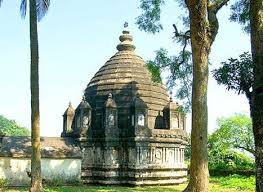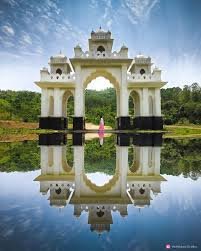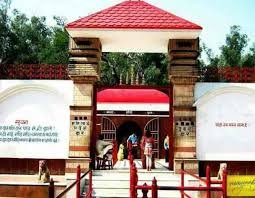Introduction
Perched on the banks of the mighty Brahmaputra River, the Aswaklanta Temple is one of the most revered temples in Guwahati, Assam. This ancient shrine, dedicated to Lord Vishnu, carries deep mythological significance and is a major pilgrimage site for Hindus.
With breathtaking views, a serene atmosphere, and rich historical importance, the Aswaklanta Temple is not just a place of worship but a spiritual retreat for those seeking peace and divine blessings. Whether you are a devotee, a history enthusiast, or a traveler exploring Assam’s heritage, this temple offers a truly soul-stirring experience.
Let’s embark on a journey to uncover the history, mythology, architecture, festivals, and divine essence of this sacred temple.
The Mythological Significance of Aswaklanta Temple
The Aswaklanta Temple has a fascinating backstory linked to Lord Krishna and the Mahabharata.
The Legend of Krishna’s Halt
The name Aswaklanta is derived from two Sanskrit words:
- “Aswa” meaning horse
- “Klanta” meaning tired or fatigued
According to legend, during the Mahabharata war, Lord Krishna and Arjuna were on their way to battle when Krishna’s horse suddenly became exhausted at this spot. As a result, they had to halt their journey. It is believed that to mark this divine event, Lord Krishna established this temple, making it one of the holiest sites in Guwahati.
Another myth suggests that Krishna’s enemies tricked him here, leading to a temporary delay in the Kurukshetra war. This divine story makes the Aswaklanta Temple a site of great spiritual importance for Vishnu devotees.
The Historical Background of the Temple
The Aswaklanta Temple was built in 1720 AD by Ahom King Shiva Singha, one of the most powerful rulers of Assam. The Ahoms were known for their patronage of temples and culture, and this temple stands as a testament to their devotion.
Although parts of the temple were damaged over time, including during an earthquake, it was later restored by devotees and local rulers, ensuring its sacred presence remains intact. Today, it stands as a reminder of Assam’s spiritual and architectural heritage.
Architectural Beauty of Aswaklanta Temple
One of the key attractions of this temple is its striking architecture. Set against the backdrop of lush greenery and the Brahmaputra River, the temple offers a picturesque and divine ambiance.
Key Architectural Highlights
Distinctive Ahom-style architecture: The temple reflects the unique construction style of the Ahom dynasty, blending indigenous Assamese elements with Hindu temple architecture.
Sacred sanctum: The inner sanctum houses beautifully crafted idols of Lord Janardana (Vishnu) and Anantasayin Vishnu in a reclining posture.
Scenic location: Built on a hilltop near the Brahmaputra, the temple offers breathtaking views of the river and the city of Guwahati. The surrounding natural beauty enhances the spiritual experience.
Temple complex: The temple consists of two main shrines—one dedicated to Janardana (a form of Vishnu) and another to Anantasayin Vishnu, depicting Vishnu in a reclining position.
The combination of divine energy, stunning architecture, and peaceful surroundings makes this temple a must-visit site in Guwahati.
Festivals and Rituals at Aswaklanta Temple
While the temple remains a serene place of worship throughout the year, it truly comes alive during major Hindu festivals.
Janmashtami – The Grand Celebration
Among all the festivals celebrated here, Janmashtami, the birth anniversary of Lord Krishna, is the most significant.
🎉 Highlights of Janmashtami Celebrations:
- Devotees gather in large numbers to offer prayers and seek blessings.
- The temple is decorated beautifully with flowers and lights.
- Special bhajans (devotional songs) and aarti ceremonies take place.
- Many devotees observe fasting and perform ritualistic pujas.
This festival transforms the temple into a vibrant and spiritually charged atmosphere, making it an ideal time to visit.
Other Important Rituals
Daily Aarti: The temple conducts morning and evening aartis, where the sound of bells and chants fills the air.
Ekadashi Fasting: Devotees observe special fasts on Ekadashi days to seek Lord Vishnu’s blessings.
Offerings and Prayers: People offer flowers, fruits, and sweets to Lord Vishnu as part of their devotion.
These rituals make the Aswaklanta Temple a center for spiritual awakening and divine blessings.
Why Visit Aswaklanta Temple?
1. A Blend of Spirituality and Mythology
The temple is deeply connected to Lord Krishna’s journey and the Mahabharata, making it one of the most significant pilgrimage sites for devotees.
2. Mesmerizing Scenic Beauty
With its stunning hilltop location and breathtaking views of the Brahmaputra River, the temple offers a peaceful retreat away from the city’s hustle and bustle.
3. An Architectural Marvel
The temple’s traditional Ahom-style architecture, intricate carvings, and well-preserved sanctum make it a must-see for history and culture enthusiasts.
4. Divine Experience
The calm and divine energy of the temple, combined with the chants, rituals, and holy presence of Lord Vishnu, offers a profound spiritual experience to all visitors.
How to Reach Aswaklanta Temple, Guwahati
The Aswaklanta Temple is easily accessible from all parts of Guwahati.
📍 By Air
The nearest airport is Lokpriya Gopinath Bordoloi International Airport (Guwahati Airport), around 25 km away. From there, taxis and local transport are available.
🚆 By Rail
Guwahati Railway Station, about 5 km away, is the closest railway hub. It has excellent connectivity with other cities.
🚖 By Road
The temple is just a short drive from the city center. You can reach it by:
- Taxi or cab services
- Local buses
- Auto-rickshaws
Alternatively, for an adventurous experience, you can take a boat ride across the Brahmaputra River to reach the temple. This offers a scenic and unique travel experience.
Best Time to Visit
Although the temple is open throughout the year, the best time to visit is:
August-September (During Janmashtami Festival) – Experience the temple’s grand celebrations.
October-March – The weather is pleasant, making it ideal for sightseeing.
Morning or Evening Hours – To witness the temple’s mesmerizing aarti.
Avoid visiting during peak monsoon season (June-July) due to heavy rains.
Conclusion
The Aswaklanta Temple in Guwahati is more than just a temple—it is a place where history, mythology, and spirituality come together. Whether you seek divine blessings, a serene retreat, or an insight into Assam’s religious heritage, this temple offers an unforgettable experience.
From its mythological legends to its picturesque location and grand celebrations, Aswaklanta Temple continues to enchant devotees and travelers alike.
So, step into this sacred sanctuary, offer your prayers, and let the divine energy of Lord Vishnu fill your heart with peace and devotion.





